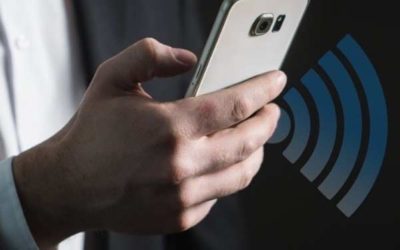Imagine a future where a box of RITZ crackers has an RFID tag that transmits a data message to Amazon that it is getting empty and automatically orders you another box. Imagine a refrigerator that tracks the volume of food and does the same thing. Imagine driverless cars, everywhere. Imagine everything that could be outfitted with a futuristic “smart” computer chip will be outfitted with one, and it will transmit some piece of information to a central hub. Whether you want this future or not, it’s coming. It’s called the Internet of Things (IoT).
What this means is that there will be many more devices than just your cell phone or tablet transmitting all kinds of data all the time. Cisco predicts 500 billion devices by 2030. To give you a point of reference, it is estimated that today (2021), there are about 35 billion devices connected on the IoT around the world (Techjury.net). That is a growth percentage of (500B – 35B)/35B *100 = 1,328%. In nine years. I doubt there has been a growth percentage of anything in that short amount of time in the history of humankind. Ok, now what?
There are three challenges we will face because of this growth.
- TRANSMIT TAX. Vendors building all kinds of smart devices and designing “RITZ cracker” transmitters to run on the IoT are not paying attention to spectrum usage, otherwise known as, bandwidth. Right now, they are enjoying what they consider to be, “infinite” bandwidth. They perceive there will be infinite capacity in the electromagnetic spectrum. Therefore, they are not designing their devices to “use bandwidth sparingly.” They are designing devices with a high “transmit tax,” because it’s easier. To explain this point further, you are likely not deleting data and photos off your phone, because your time is more valuable than the cost of the storage capacity on your 128GB phone.
- Don’t Touch my Spectrum. Right now, the electromagnetic spectrum is owned in slices. The telecom companies own a significant portion of the EMS and are continuing to buy more (this is wreaking havoc on the DoD’s ability to train and equip, but that is a subject for another blog). Other owners include HAM radio operators, the GPS companies, and satellite companies. As the Internet of Things promulgates and more and more demand is placed on spectrum use, each owner must work to maximize capacity within their owned bands. Case in point: the US Government (Congress) recently just sold off $87B more dollars-worth of spectrum to the telecoms, taking it away from the DoD. Pretty soon, though, these exclusively owned bands will run out of capacity. Why would the telecoms need to buy more spectrum if they weren’t coming up against the limit? They just bought a whole bunch less than two years ago. With them spending this kind of money to own more and more spectrum, they have way too much invested to start cooperating by recombining the EMS and finding ways to share spectrum ubiquitously. With the spectrum fractured, no one is working on solutions that would harness the power and potential of the EM spectrum if it were to be recombined. There are other options to the standards we have in place now – just sayin’…(topic for yet another blog).
- EM Spectrum, everywhere? NOT. There is no incentive for the telecoms to build infrastructure everywhere because the cellular infrastructure is currently a money-making commodity. However, the Internet of Things will ultimately drive the spectrum to become what is classically known as a public good. Like clean water and fresh air, the EM spectrum is quickly becoming an indispensable resource that is a matter of life and death. Right now, if your text to mom to ask if you should pick up milk doesn’t get to her, no one’s life is at stake. But, when driverless cars are on the road, and when people are walking around with pacemakers that call for a life-saving signal from the doctor’s office, we will have a social and public obligation to make sure the EM spectrum is available for everyone.
There are two recent examples of lack of spectrum capacity that are worth mentioning. One is 9/11. In 2001, dozens of emergency units showed up at the World Trade Center to assist in search and rescue and guess what? Between the civilians attempting to use the cellular network and the emergency personnel using their two -way radios, no one could get through…for days. There was no pre-planning for such an event. God save us from having such a day again, but in the meantime, we need to start planning now. The second occurred in 2020 with the COVD-19 lockdown. Students were ordered to stay home from school and take up online learning. Hundreds of rural and indigent inner-city communities were unable to provide basic bandwidth for their young people to learn from home. Both problems emerged because our nation isn’t thinking about the EM spectrum as a public good, but rather as a commodity for the privileged, and the paying consumer. Congress’ recent decision to sell more spectrum to the telecoms is a perfect example of that mindset. Continuing to treat the EM spectrum as a commodity will compromise the public and our national defense. We must consider alternatives as we move through this decade.
As you get on with your day, please take this one thing with you: the Internet of Things will invoke a demand for EM spectrum that will exceed current capacity and even our best planning measures within this decade. The sooner we accept this truth the better, so we can start planning and preparing for the Internet of Things and an electromagnetic spectrum that is fully employed to accommodate it.
Photo Credit: Examcollection.com





0 Comments